HENRY TERRELL, Contributing Editor
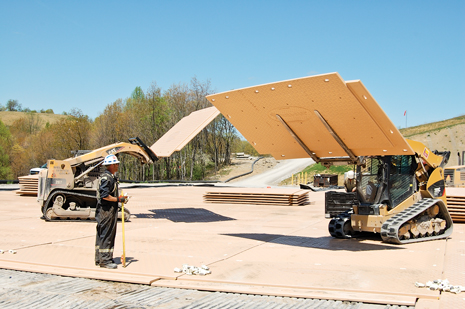 |
| DURA-BASE is an interlocking mat system that provides stable worksites and ground protection, supporting drilling rigs and completions operations. The system can also be used to construct temporary roadways for rugged or sensitive terrain. |
|
In the broad categories of health, safety and environmental products and systems, the overlap is so complete, it becomes obvious why this field is known simply as “HSE.” A product that improves workplace safety is clearly beneficial to worker health, while another that mitigates environmental problems likewise contributes to public safety and quality of life. The three are inseparable.
It’s also true that the “E” in HSE could just as easily stand for “economics.” In purely dollars-and-cents terms, risks to worker health and safety, or to public safety, or a sound environment, are expensive. A trained, skilled employee is a valuable investment to be protected. Additionally, risk to a company comes not just from loss of production, added downtime and the necessity of training new workers, but in individual and class-action lawsuits. Damage to a company’s reputation and brand are less quantifiable but just as real. Safe environmental practice is good business.
Greenfield OCTG construction. Reducing environmental impact begins before a well is even drilled. Tenaris is currently building a new “greenfield” seemless pipe mill in Bay City, Texas, near Houston, for the manufacture of OCTG products. With a $1.5-billion investment, the facility, called TenarisBayCity, is designed and will be constructed under stringent environmental and safety standards.
The plant will implement several air emissions technologies, such as selective catalytic reducers (SCRs). These are used in the exhaust stream of internal combustion engines to reduce NOx, and are designed to significantly reduce the plant’s emissions footprint to exceed both state and federal regulations. These NOx emissions are also mitigated by applying advanced burner design to maximize efficiency.
Volatile organic compounds will be kept to a minimum by the use of water-based varnish coatings, with add-on controls, such as thermal oxidizers, to reduce remaining organic compounds. The closed-loop water system is designed to have the smallest possible impact on local water resources. The facility will apply for LEED (Leadership in Energy and Environmental Design) certification, a rating system developed by the U.S. Green Building Council.
The mill is projected to produce 600,000 tpy of seamless pipe.
Composite mat system. The first line of defense in safety and ground protection for drilling and completions operations is the mat. The DURA-BASE Advanced-Composite Mat System from Newpark Mats & Integrated Services is used widely throughout North America and other parts of the world for stable worksites and ground protection. The system is also utilized to construct temporary roadways for accessing difficult or sensitive terrain. In environmentally sensitive areas like the Marcellus and Utica shale plays in the northeastern U.S., the mat system is deployed atop spill-containment poly-liners to safeguard against premature failure resulting from wear and tear. DURA-BASE is part of an integrated system that includes ramps and berms, as well as a fully automated mat-cleaning system that minimizes the use of water and speeds up remobilization.
Each mat measures 8 ft × 14 ft × 4.25 in. thick and is tested to support loads up to 1,000 lb/sq in. The mats are made of an advanced-composite formulation that weighs half as much as wooden mat alternatives. This lightweight design allows more mats to be carried on each truckload (45 DURA-BASE mats vs. 20 wooden mats), not only reducing fossil fuel consumption and emissions, but also lessening road wear. The composite material also contains an additive that eliminates potentially dangerous static buildup.
The mat system features a connection system that interlocks on all four sides. This minimizes differential movement, helps prevent load destabilization and creates a continuous, temporary work surface that reduces the risk of trips, slips and falls. The twist-lock fasteners and overlapping lip system ensure a continuous barrier between ground and work surface, eliminating the possibility of individual boards coming loose and damaging equipment, and also preventing the pinching and tearing of liners. This complies with environmental regulations and significantly reduces maintenance and rig downtime, due to liner repair and leak mitigation.
DURA-BASE mats are 100% recyclable and can be reused multiple times, typically lasting five times longer than wooden alternatives. A specially designed tread pattern and anti-skid surface material prevents slips, and improves pedestrian and vehicle traffic.
Coiled tubing inspection in real time. The safest, cost-effective techniques are those that prevent problems before they occur. The CoilScan real-time, CT pipe inspection system from Schlumberger is a portable device that detects internal and external CT damage or defects on CT pipe sizes ranging between 1¼ in. and 27/8 in. diameter, Fig. 1. When used in conjunction with CoilLIMIT coiled tubing pressure and tension limit modeling and interpretation software, the CoilScan measurements provide enhanced operational safety by accurate determination of the operating envelope of the coiled-tubing pipe. Non-invasive, real-time monitoring of CT pipe condition before, during and after jobs can eliminate costly problems during CT interventions.
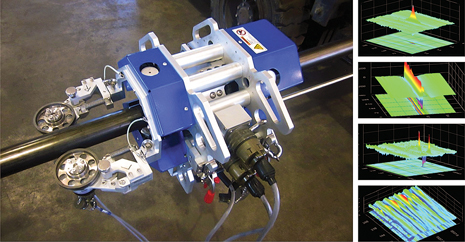 |
| Fig. 1. The Schlumberger CoilScan system provides a full array of measurements every 0.005 in. 3D modeling software produces MFL output signatures that detect pinhole leaks, as well as butt and seam welding defects, both internally and externally. |
|
Previously, coiled tubing evaluations were limited to visual inspection and fatigue calculations that totaled the number of flexures under stress. With the CoilScan technology, these calculations are augmented by detailed, non-destructive metal inspection using magnetic flux-leakage (MFL) and eddy current techniques to reveal continuous wall thickness, and spot defects and ovality that could cause anything from pin-hole leaks to catastrophic failure.
Safer logging. Chemical neutron sources are used with measuring devices in logging-while-drilling (LWD), and these involve the possible exposure of personnel or the environment to these chemical sources, when they are transported, loaded and unloaded. NeoScope from Schlumberger is the industry’s first “sourceless” formation evaluation-while-drilling service. Fig. 2. The system uses pulsed neutron generator (PNG) technology in the shortest LWD collar available. The neutron supply is controlled by the power voltage applied to the PNG, which removes chemical source transportation risks and associated costs, and eliminates the HSE risks found in loading and unloading.
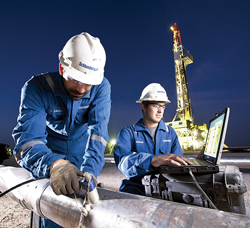 |
| Fig. 2. The industry’s only sourceless formation evaluation-while-drilling service uses pulsed neutron generator technology for formation evaluation. (Photo courtesy of Schlumberger) |
|
The service provides a number of measurements, including azimuthal gamma ray, array resistivity, dual ultrasonic calipers, sourceless neutron-gamma density, neutron porosity, spectroscopy, sigma and a full drilling mechanics package. For exploration drilling, the NeoScope service enables operators to avoid complex fishing, sidetracking or abandonment features. In unconventional plays, the service delivers critical data to optimize completion quality and enhance efficiency, in addition to providing sourceless measurements in real time, for better well placement.
Mobile treatment for flowback water. Development of unconventional oil and gas presents an opportunity to use one of the oil field’s oldest challenges—unwanted produced and flowback water—as a source for the water needed to perform hydraulic fracturing.
Cost-effectively managing this water can mean the difference between economic success and failure in many hydraulic fracturing operations.
Effective surface water management requires scientific knowledge of the composition of the water and how that water could be impacted by reservoir temperature and pressure, rock characteristics, the wellbore, and surface handling and treating techniques. Understanding these water chemistry variables is critical to ensuring reservoir productivity, well integrity and a safe environment.
The H2prO water management service from Baker Hughes (Fig. 3) combines a comprehensive suite of solutions, a dedicated team of oilfield water application engineers, mobile treatment systems and effective processes to enable up to 100% reuse of produced and flowback water in hydraulic fracturing operations, without potential damage to the reservoir. One system, the H2prO heavy metals and solids (HMS), uses a non-chemical electrocoagulation process to remove contaminants that can damage the reservoir and cause electrode scaling. Unlike traditional electrocoagulation systems, the H2prO HMS service uses a design that prevents electrode fouling to ensure consistent, dependable treatment. Additionally, the applied electric field improves contaminant coagulation for better separation efficiency compared to chemical treatment methods.
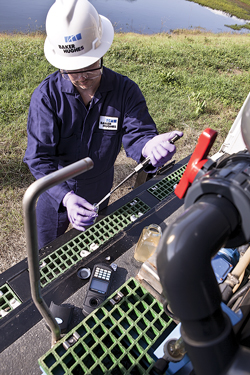 |
| Fig. 3. The H2prO water management service from Baker Hughes offers a comprehensive suite of solutions via mobile treatment systems that effectively and safely process produced and flowback water for 100% reuse in hydraulic fracturing operations. |
|
Using the H2prO service, a Texas operator was able to treat an entire volume of 1.16 million gal of produced water on the fly, and reuse it to fracture 17 stages. Using treated produced water, instead of fresh water, eliminated freshwater and disposal trucking costs, and significantly reduced operating expense for the job.
Environmentally sound scale control. For oil fields around the world, oil production means water production, and a risk of mineral scale formation. If left unchecked, mineral scale deposits within the near-wellbore, in production tubing and on processing equipment, inevitably lead to a slowdown in production. Aggressive under-deposit corrosion is also likely, leading to production leaks that may threaten the surrounding environment.
While chemical treatments fight to inhibit scale formation, and have been in use for decades, the push for greener treatment alternatives has spurred the development of more environmentally benign technologies. Weatherford has pioneered the development of a novel solution called ClearWELL, a water-treatment technology that employs a high-frequency AC signal to create an electromagnetic field within the production tubing and equipment. This signal, which travels through the pipe and production equipment, allows scale crystals to form in suspension and remain suspended in the produced fluid, rather than allowing them to deposit and grow on the internals of the production system, Fig. 4.
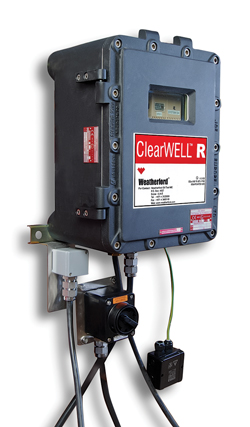 |
| Fig. 4. The ClearWELL system from Weatherford is installed on the outside of the surface conduit. The signal can be transmitted throughout the well conduit, from the surface to the bottom of the well and through the separation system, and allows scale crystals to form in suspension and remain suspended in the produced fluid. |
|
The system is chemical-free scale control technology that is installed on the outside of the surface conduit, avoiding environmentally risky, costly well interventions. The signal can be transmitted throughout the well conduit, from the surface to the bottom of the well, and through the separation system. This technology has been able to control scale deposition as deep as 17,000 ft. It is also compatible, and does not interfere with, a pipeline’s cathodic protection system. Significantly, the system does not add anything to the produced water that was not already present. The tiny scale particles form in suspension and remain suspended throughout the normal separation process.
ClearWELL has been used extensively worldwide. In a recent six-month trial in the Middle East, the technology was deployed to prevent calcium carbonate and strontium sulfate scale depositions in downhole and surface applications in a well using an ESP for artificial lift. Through the use of mechanical ID-gauging methods, it was possible to track the progress of scale build-up on the internal tubing walls.
ESP performance was closely monitored and continuously compared to historical baseline performance. The device exhibited an ability to inhibit mineral scale deposition inside the tubing string and within the ESP pump, while reducing the overall use of acids and chemicals in the well.
Cleaner alternative for hydraulic fracturing. Diesel fuel has powered high-horsepower hydraulic fracturing pumps for decades. While proven and effective, diesel creates risks for air emissions and adds other HSE problems in transportation and refueling operations.
Bi-fuel pumps burn a mixture of natural gas and diesel to reduce diesel use by up to 70% and slash a number of emissions. The pumps also capitalize on the availability of the natural gas that operators have unlocked in unconventional resources. Baker Hughes is a pioneer in bi-fuel hydraulic fracturing technology with its Rhino bi-fuel pump fleets. The pumps can operate twice as long as engines running solely on diesel, improving safety by eliminating refueling during pumping.
The company introduced bi-fuel hydraulic fracturing North America during the fall of 2012 by converting a small fleet of pumps in Canada. When results were successful, the company converted an entire fleet in the U.S. During the first two quarters of 2013, they completed 24 bi-fuel pumping jobs and pumped 404 cumulative stages from October 2012 through June 2013 using liquefied petroleum gas (LPG).
Recently, the company achieved another significant milestone, fracturing a series of wells in the northeastern U.S. and the Rockies using line gas from the field to pump 240 stages over 18 different wells. Using the operator’s line gas displaced more than 100,000 gal of diesel and eliminated several shipments of fuel to rural areas, achieving significant cost savings.
By the end of 2014, the company anticipates that more than 25% of its hydraulic fracturing fleet in North America will be fully bi-fuel capable. The company expects that to grow to more than 50% over the next three to five years.
Fracturing technique enhances production, safety. The HiWAY flow-channel fracturing technique from Schlumberger incorporates a workflow process that consistently delivers significant production improvements in horizontal and vertical completions, Fig. 5. The versatile technique has applications in shale formations with naturally fractured networks and in single- or multi-stage completions. It is also suitable for consolidated rocks, and works over a wide temperature range. The proppant deposited by the technique supports the fracture while creating infinitely conductive flow channels through the pack. Production is improved, with fewer screenouts and with reduced completion costs.
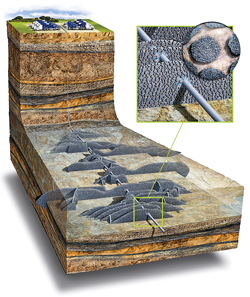 |
| Fig. 5. Schlumberger's HiWAY flow-channel fracturing technique can be applied to all or to select stages of a multi-stage stimulated completion. Proppant ‘pillars’ (inset) support the fracture, leaving a network of linked infinite conductivity channels between the fracture tip and the wellbore. |
|
A combination of a unique pumping technique and innovative fluid engineering, the HiWAY process delivers conductivity all the way from the wellbore to the fracture tip. This allows for longer effective half-lengths, higher effective contact areas, better fluid and polymer recovery, and less fracture face damage. The cumulative effects are better productivity and superior hydrocarbon recovery.
Rod lift systems giving way to safer ESPs. After years of setting the standard for artificial lift in conventional mature fields with low flowrates, rod lift systems are being challenged, particularly in unconventional fields, by ESP solutions. An operating range paradigm shift, and a perfect convergence of technology services and commercial models, are making ESP-based solutions reliable, economically viable and environmentally preferred across the broad production range exhibited by these unconventional fields.
The new ProductionWave suite of products and services from Baker Hughes epitomizes this trend, helping operators in unconventional plays increase production rates—in some cases by more than 40%—while lowering installation and maintenance costs, and reducing HSE risks when compared to rod lift operations.
The ProductionWave solution, featuring FLEX pump technology, is primarily targeted at unconventional oil plays in which post-frac production rates decline rapidly, and wellbore trajectories prove troublesome for rod lift systems. FLEX pumps can operate in flow ranges from 50 to 4,000 bpd, enabling operation in dynamic producing conditions while providing better associated gas and solids-handling capabilities than traditional rod lift systems.
Rod lift systems can stand 47 ft tall, with numerous moving parts at the surface. At 4–6 ft tall, ESP systems (Fig. 6) are more landscape-friendly and have no exposed moving parts at the surface. In addition, ESPs eliminate the risk of personnel becoming entangled in the rotating equipment. Operation is less intrusive, with no potential of wellhead leaks. Well performance is continuously monitored to stay ahead of changing conditions and can be monitored remotely.
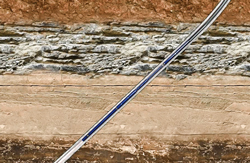 |
| Fig. 6. While traditional rod lift systems can tower over the landscape, with many moving parts exposed, Baker Hughes ESP systems have no exposed moving parts at the surface, making them safer and more environment-friendly. |
|
In a 2013 example from the Bakken play, the rod lift system became unreliable as the well declined, and the gas/liquids ratio increased. Three rod failures cut production rates from 200 to 100 bopd. The operator converted to a Centrilift FLEX 3.2 pump system and a variable-speed-drive (VSD) surface component. These were supported by newly developed algorithms that detect gas issues and automatically adjust operating parameters to adapt to gas events. After the conversion, oil production increased 42%, with no gas-, rod-and-tubing-, or ESP-related downtime.
In another ProductionWave example, well performance was monitored to determine whether conversion from gas lift to ESP was economic. Oil production increased by more than 75% and gas production by more than 60%, providing an ESP conversion payout in less than
one month. 
|









